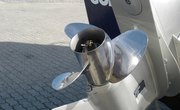
When most people talk about a marine gear ratio, they mean the reduction ratio of the motor that expresses the number of times the motor turns--the number of revolutions--to turn the propeller once. Gear ratios vary between manufacturers, between the engine models of each manufacturer and between High Thrust and regular gear ratios. All you need to know to start the calculation is the pitch of your boat's propeller. Then all you need to do is go boating with a few extra supplies
Items you will need
GPS unit (Global Positioning System receiver)
Pen
Paper
Calculator
Look at the side of the hub of your boat's propeller and find two numbers separated by an "X." The first is your propeller's diameter. The second is the propeller's pitch. Record the pitch with pen and paper.
Launch your boat and motor away from the dock area. Accelerate slowly until your motor's tachometer (RPM gauge) is reading 2,000 RPM. Look at the GPS and note your exact speed.
Stop your vessel in a safe area and, using your calculator, multiply the speed by 1,056 (the Constant for Unit Conversion). Divide this result by the pitch of your propeller. Record this First Result. If your speed at 2,000 RPM was 10 knots, then: 10 x 1,056 = 10,560.
Divide this result by the propeller's pitch again. Record this Second Result: if your propeller's pitch equals 12, then: 10,560 / 12 = 880
Divide 2,000 by the Second Result; the answer is your gear ratio: 2000 / 880 = 2.272727, or 2.27 to 1 (2.27:1)
Warnings
- Don't try to make these calculations while driving your boat. Pull over to the shore or to a place where you will not be disturbed.
Warnings
- Don't try to make these calculations while driving your boat. Pull over to the shore or to a place where you will not be disturbed.
Writer Bio
Will Charpentier is a writer who specializes in boating and maritime subjects. A retired ship captain, Charpentier holds a doctorate in applied ocean science and engineering. He is also a certified marine technician and the author of a popular text on writing local history.



